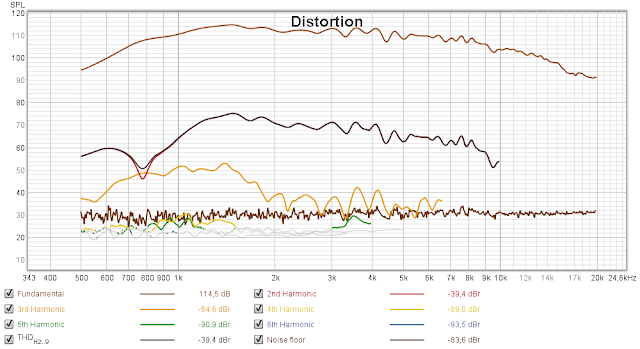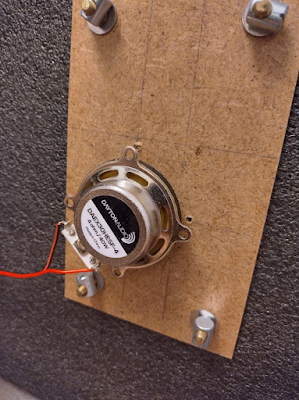I have acquired and tested a new set of DIY speakers, Aktiivinassakka. The tweeter in it is the Eighteen sound NSD1095N compression driver on a XT1086 horn. The horn is treated with a butyl mat to dampen ringing of the horn. Here are some measurements of the tweeter alone. Output was LR48 high-passed at 150 Hz to protect the driver from damage, but it probably would have handled the measurements just fine. The driver was detached from cabinet and driven on soft platform covered in pillows to reduce echo. Detaching from cabinet can cause the horn to ring despite of damping, so some of the anomalies can be result of that. I was wearing hearing protection throughout the testing.
The equipment and test conditions.
- Preamp: miniDSP SHD. Dirac and some other dsp disabled.
- Amp: Hypex NC400 monoblock.
- Driver: NSD1095N, 16 Ohm version with a XT1086 horn.
- Mic: UMIK-1, placed at the mouth plane of the horn.
- All RTA measurements were done with same positioning and volume settings.
- Background noise sources: Computer, fan of Raspberry Pi, ticking clock. Untreated living room. Subjectively pretty quiet at the moment of measurement.
- Software: REW.
- Signal: varies, descripted at screenshots.
- RTA: FFT 64k, Blackman-Harris-7, 8 averages.
- Series resistance, three test cases,
- Test case A: driver is hooked up directly to NC400 binding posts with short speaker wire.
- Test case B: between driver and amp there is 40 Ohms worth of resistors and some speaker wire.
- Test case C: between driver and amp there is 112 Ohms worth of resistors and some speaker wire.
- Volume was leveled between test cases with 0.5 dB precision. Some exceptions might have occurred, but measured fundamental levels are stated in screenshots.
Measurements
To put things into perspective, this Eighteen Sound compression driver together with the NC400 amplifier has very low harmonic distortion. In this nearfield measurement into calibrated mic, at 114 dB at typical crossover frequency, it has maximum THD of 1.1 % over intended frequency range. It's dominated by 2nd harmonic, which is typical for compression drivers and the 3rd harmonic doesn't rise above 0.1 %.
 |
| Nearfield sine sweep at high output level. Test case A. |
CCIF
Next up intermodulation distortion tests. Running the bass tones on a tweeter makes no sense, so I skipped those IMD measurements. Let's start with the REW's CCIF dual tone signal: 19 kHz & 20 kHz, 1:1 ratio.
 |
| Test case A |
 |
| Test case B, 40 Ohms. |
 |
| Test case C, 112 Ohms. |
CCIF test case C shows peaks at 2, 4, 6 and 8 kHz, that were absent in case A. Peaks are so small that it can be an outside source that leaked in. The peaks are present in case B to some degree.
AES-17 DFD
18 kHz & 20 kHz, 1:1 ratio.
 |
| Test case A, direct. |
 |
| Test case B, 40 Ohms. |
 |
| Test case C, 112 Ohms. |
Almost no change at all. Tiny variances at 3, 4, 6, 7, 8, 10 kHz in favor of case A.
TDFD akl
13586 Hz & 19841 Hz, 1:1 ratio.
 |
| Test case A, direct. |
 |
| Test case B, 40 Ohms. |
 |
| Test case C, 112 Ohms. |
Almost no change. Peak at 400 Hz is lower in case A, but peaks at 3 and ~5.1 kHz are lower with case C.
TDFD Phono
3005Hz & 4462 Hz, 1:1 ratio.
 |
| Test case A, direct. |
 |
| Test case B, 40 Ohms. |
 |
| Test case C, 112 Ohms. |
It's like finding Waldo...
Borberly
Now triple tones. 9 & 19 & 20 kHz.
 |
| Test case A, direct. |
 |
| Test case B, 40 Ohms. |
 |
| Test case C, 112 Ohms. |
Test case A has lower peak at ~970 Hz and no peak just over 1 kHz. Case C does not display any peak at 2 kHz.
Cordell
9 & 10.05 & 20 kHz.
 |
| Test case A, direct. |
 |
| Test case B, 40 Ohms. |
 |
| Test case C, 112 Ohms. |
Test case C does not have peaks at just over 400 Hz and at 2 kHz. The next peak after 2nd fundamental is slightly lower in case A.
Klingelnberg
10.5 & 19 & 20 kHz.
 |
| Test case A, direct. |
 |
| Test case B, 40 Ohms. |
 |
| Test case C, 112 Ohms. |
This signal has probably the most differences between our test cases. Case A has lower peak at 1 and 2 kHz. Case C doesn't have any peak at ~7300 Hz and smaller peaks at 6 and 6.5 kHz.
Conclusion
I expected to see bigger differences, but I guess that the combined harmonic distortion of the amplifier and loudspeaker driver was too small for a meaningful improvement. Also the speaker driver is a 16 Ohm version, which alone perhaps minimizes most distortion that could be achieved with series resistance.
























Comments
Post a Comment